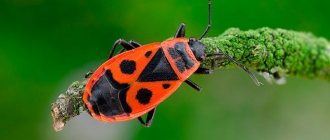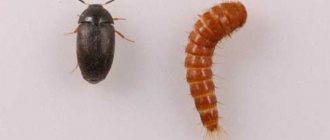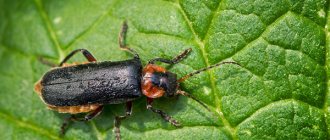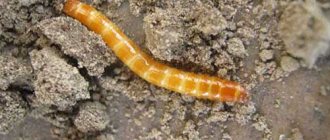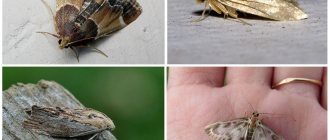Wood-boring beetles represent a class of actively reproducing individuals that attack and damage various woody materials at a high rate. Therefore, it is important to have an understanding of the varieties of these pests and take preventive and control measures in a timely manner.
A real woodworm looks like this:
woodworm
You can read more about woodworm in this article.
But out of ignorance, other wood-eating insects are also called wood-boring beetles. Let's look at it below.
Longhorn beetle
They are sometimes confused with the black brownie barbel and the brownie woodcutter. In the process of reproduction and development, beetles go through all the classic stages for this type of organism: larvae are formed from eggs, which then turn into pupae, and then into adults.
black longhorned beetle
Adult insects have a body length ranging from 7-21 mm, their scutellum is short, widely rounded at the rear. The elytra are slightly elongated and convex. The antennae are short and thin, reaching the middle of the elytra. The color of the beetles may vary, depending on the area of settlement, from light brown to deep black. The same applies to the distribution of light gray or white hairs along the elytra.
Wood-boring beetles invade and mainly infect dry coniferous wood. The active breeding season occurs in the warm season - after May.
Important! These insects do not tolerate humidity above 20%, so females lay eggs mainly in the cracks of already dead trunks and lumber.
As a result of the vital activity of these parasites, winding labyrinths of passages are formed on the wood, powdered with a rash like whitish flour. The larvae can usually be found under old bark, if it has not been removed from the logs from which the log house was built.
Reasons for appearance
This pest can appear in the house for a number of reasons:
- When already contaminated wood is used at the construction stage of a building or structure.
- Use of old, unkempt wood with cracks and crevices.
When wood is harvested from the forest, it can be stored on the site for a long time. This is a fertile place for wood-boring beetles to breed. If we also take into account the high humidity, then these are ideal conditions and all the beetles simply flock to this place to lay eggs. After this, various structures are made from this wood. If the tree is not treated, then the larvae that emerge from the eggs will immediately begin to destroy the wood, or rather products made from it.
https://youtube.com/watch?v=WQO2CiWP2_Q%3Frel%3D0
Spruce beetle
Another name for this insect is dendrocton. It is widespread in some European countries - England, Italy, Norway, as well as in the Far East, the Baltic states and Russia. As for the climatic zone, dendrocton is usually found in the taiga, sometimes in the steppe zone.
The pine beetle is capable of making short flights and thus colonizing new territories. It is also distributed along with sawn wood sent for sale to other regions.
Important! The pine beetle mainly affects such wood species as Siberian, European, and Ayan spruce, as well as several types of fir and Scots pine.
The body length of adult individuals is 5-7 mm, the shape is characteristically oblong, valval. Fine hair can be seen on the surface. The color of the beetle is shiny black, brown or dark brown with rusty red antennae and legs. The mustache is usually club-shaped.
There are also large and small pine beetles, you can read more about them HERE.
The small pine beetle eats up a shoot.
During their life, females carve chambers in the trunks where they lay their eggs.
The larvae hatched from them begin to actively absorb the wood, due to which peculiar tunnels are formed not only on the surface of the logs, but throughout their entire internal structure. At this stage, the insect molts several times, after which it gnaws another chamber for itself and pupates in it.
Is it possible to use wood infested with pests rather than treat it?
Wood infested with pests is suitable for further use only after the destruction of the bugs that have settled in it. Otherwise, its inhabitants will continue their destructive actions, as a result of which the building, built from damaged building materials, will collapse.
It is recommended to remove the affected parts of the raw material, after which healthy areas are painted in several layers. Additionally, you can introduce a protective agent through drilled holes into already infected but still strong wood. You need to drill, plunging as deeply as possible into the body of the tree.
False bark beetle
This woodborer is popularly called the hooded woodworm. It is more common in areas where a mild and warm climate prevails.
Important! What sets this parasite apart is that it is capable of damaging wood of any density, including carrying out its life activity in the structure of very hard oak trunks. And it is this factor that influences exactly how the beetle gnaws its passages - usually along the structure of the fibers.
False bark beetle or hooded beetle
False bark beetle can be found in wooden wells, support posts and fences. They usually do not live in furniture and household items. He prefers to settle in wood that has not been subjected to antiseptic treatment. Sometimes you can find some species of capillaries in cereal grains. It is quite difficult to identify insects visually. More often, their presence is indicated by a specific type of “groove”.
Adults grow to a length of 15 mm. The head is covered by the pronotum, which looks like a hood. Beetles common in Russia are characterized by black coloration with a red abdomen and elytra.
Prevention measures
- To avoid the appearance of bugs in the apartment, it is necessary to ventilate the room as often as possible, especially kitchen cabinets.
- It would be a good idea to wipe them from the inside with a cloth soaked in vinegar.
- When buying cereals and pasta, you need to look at the packages with their contents, as they may already contain pests.
- When purchasing furniture, you should also inspect it for the presence of characteristic holes.
- It is advisable to treat all wooden materials that are used to decorate the apartment with an antiseptic (Antizhuk, Wood Healer).
- To prevent bugs such as springtails from appearing in your apartment, you should not over-moisten the soil in which the plants grow. In addition, it is a good idea to sprinkle some ash on top of the soil.
- Stocks of cereals can be stored on the balcony in winter to prevent beetles from infesting.
- And, of course, keep the apartment clean, vacuum furniture and carpets more often, treat them with steam, and prevent dampness in the bathrooms; Take out the trash promptly.
We suggest you read: Flour beetle - How to get rid of it?
Pests cause significant damage to human property if they become infested; fighting them is long, expensive and difficult. Therefore, it is easier and more profitable to take preventive measures against their occurrence. The basis of prevention is regular ventilation of the room, thorough cleaning and keeping the wooden elements of the interior clean.
“Polish” or “Losk” is perfect as a care product; their composition allows you not only to repel the grinder beetle, but also to maintain the furniture in good condition for a long time. Some wooden surfaces will be protected by regular and timely painting and varnishing. Untreated wood can be wiped with a chloramine solution or turpentine.
Furniture grinders love dampness, so to prevent their occurrence, it is advisable not to store wood in damp and unventilated places.
Also, to prevent damage to wood by pests, it is necessary to treat the logs at the construction stage, using compounds such as “Phoenix”, “Pinotex”, “Senezh” and others.
Weevil beetle
Weevils differ from other types of wood borers in that they not only inhabit non-living tree trunks, but also parasitize other plant species. But most often, weevils can be found in tree trimmings or in firewood that lies in an open area and is exposed to rain, as well as on fruit trees. In total, about 5,000 species of these beetles are common in Russia.
A distinctive feature of weevil beetles is the elongated part of the head at the front, which is called the rostrum. Weevils can be either short-proboscis or long-proboscis.
Find out more about weevils HERE.
Weevil beetles
The body length of weevils can also vary, on average from 1 to 30 mm. There is also no single shape - you can find individuals with cylindrical, oblong, rhombic, hemispherical, spherical, etc. body. The color is yellow, brown or black, sometimes with pronounced spots on the pronotum and elytra. These spots allow the insect to successfully camouflage itself among plants. The paws have a red-brown tint or yellow color. The upper part of the insect is covered with wide scales or hairs, or it may be completely bare. On the elytra
Weevil larvae without legs come in different shades - from white and cream to red and brown. The shape is characteristic sickle-shaped.
Borer beetle
This type of coleopteran insect is also called the driller or drill . This is not at all accidental, because during their development, the larvae of this beetle literally drill tunnels, the diameter of which reaches 2 mm. This is precisely where the main harm from these insects lies, since they do not feed on the wood itself, but only eat the mycelium, which grows in these dug canals.
driller or driller
Important! The borer most often affects tree species such as oak and walnut, as well as any coniferous species. The speed at which drilling damages and thereby reduces the strength of wood building material is astonishing. Only one family can quickly deteriorate the first crown of an oak frame
The length of an adult is from 7 to 18 mm. The body is soft, has an elongated cylindrical shape, on which shortened elytra are located. The tarsi are quite long and have intermediate segments. You can better recognize a specific type of wood-boring beetle from photographs of different pests.
Grinder
The damage from this beetle can be colossal, as it affects living trees, household items made of wood, and entire buildings. It prefers high humidity and coolness, so it settles in walls or furniture located on the north side.
beetle grinder
What greatly complicates the task of detection is the absence of external signs of infection. The grinder carries out his activities inside the material. Therefore, the most effective method in this case is using an electronic stethoscope. With its help, you can hear the characteristic “ticking” sound with which males attract females for mating and procreation. What is noteworthy is that adult individuals usually do not live long, since their main function is reproduction.
The beetles themselves are small in size, usually 4-5 mm, sometimes their body length reaches 10 mm or can be only 1 mm. There are combed and serrated antennae, the larvae have well-developed legs and claws with 2 setae. The classic color is dark gray with a brown tint. On the sides there are usually 2 spots covered with golden hairs. The lower part has more pubescence than the upper.
Shashel
This type of woodworm has a characteristic white body, covered with the same light hairs. There are 2 black bumps on it. The main danger is represented by shashel larvae, which dig through numerous tunnels inside trunks, lumber, and logs. The insect can remain in the larval stage for up to several years. What is characteristic is that these channels do not reach the surface - the beetles and larvae stop approximately 1 mm from the bark. Because of this, the woody material or trunk may look normal on the outside, but be completely rotten on the inside.
cabbage larva
The larvae pupate closer to the core, where they turn into adults.
What else do you need to know about wood-boring beetles?
- Parasites begin to be active with the arrival of warm weather in the spring; this period mainly occurs in May-June.
- You can infect your home with such pests yourself if you purchase lumber with larvae or pupae inside. Therefore, it is important to carefully look at the product you choose.
- We must not miss the moment to combat wood borers, otherwise the damage from their pest activity can be very significant. As soon as you notice the appearance of potholes, wrinkles, the presence of mealy powder or a brownish liquid with a sharp sour odor on wood materials, take action immediately.
- The larvae of some species can be detected quite quickly by removing part of the bark, or using modern devices.
To combat woodworms, the most effective method, but not guaranteed, is fumigation with phosphine. You can also consider the method of microwave disinfestation against beetles in the house. Only XILIX GEL can guarantee that there will be no bugs in your house for 10 years!
Fumigation - when is it necessary and how is it carried out?
If there are tree beetles in a house or wooden building, and their numbers have increased so much that none of the listed remedies help, you can try to fumigate the area with insect-infested surfaces.
Fumigation is a method of controlling harmful insects using special aerosols or smoke containing fumigants. It would be appropriate to use magnesium or aluminum phosphide.
Before starting the procedure, it is mandatory to remove all pets from the premises, and also free it from family members. Food, dishes, toys, and clothes are carefully covered with film. Windows, doors and vents are tightly closed.
The smoking process will take several weeks on average, but will depend on the room temperature. After completing the procedure, wet cleaning is carried out using a solution of soda ash.
Considering that fumigation is carried out by trained employees of a special service and requires so much time, it makes sense to seek help only if the bugs cannot be exterminated and continue to annoy. It is also important that residents of a house or apartment where woodworms have infested have the opportunity to leave their home for the required period.
